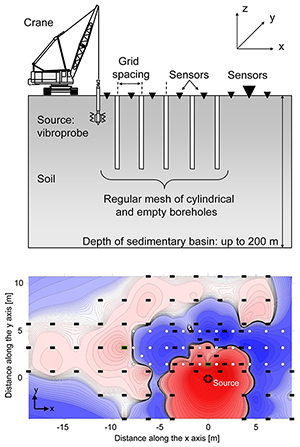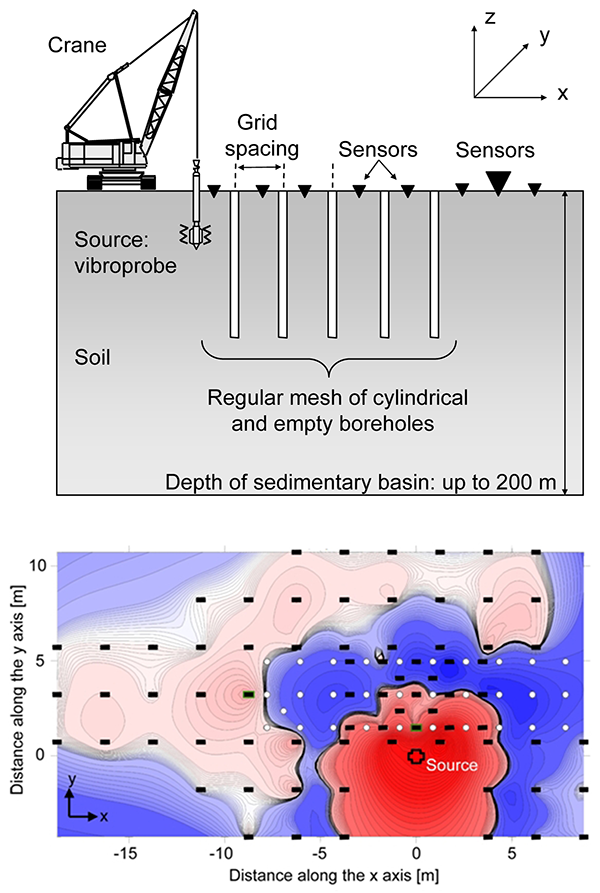A Step Towards a Seismic Cloak
Phononic, photonic crystals and metamaterials are man-made structures that can control sound and light in ways not found in nature. Whereas the properties of phononic and photonic crystals derive from the periodicity of their structure, those of metamaterials arise from the collective effect of a large array of small resonators. These effects can be used to manipulate acoustic and electromagnetic waves in unconventional ways, realizing functions such as invisibility cloaking, subwavelength focusing, and unconventional refraction phenomena (such as negative refractive index and phase velocity). Recent work has started to explore another intriguing domain of application: using similar concepts to control the propagation of seismic waves within the surface of the Earth. Now, the research group of Sebastien Guenneau at the Aix-Marseille University and French National Center for Scientific Research (CNRS) has teamed up with civil engineers at an industrial company, Ménard, in Nozay, also in France, and carried out the largest-scale test to date of seismic metamaterials [1]. The reported experimental results are encouraging: an artificial structure built around a target can be used to deflect incoming acoustic waves at a frequency relevant to earthquake protection. This preliminary success in the laboratory could one day translate into a way of mitigating the destructive effects of earthquakes.
When an earthquake occurs, seismic waves are created by slip zones deep below the Earth’s surface. When these underground waves [which can be longitudinal waves ( waves) or transverse waves ( waves)] meet the surface, part of their energy is converted into waves that propagate along the Earth’s surface. These surface waves, also called Rayleigh waves, are usually observed in the frequency range of less than hertz to a few tens of hertz, since the higher frequency components are more effectively attenuated during wave propagation. They have a much slower speed, hence a smaller wavelength, than underground waves and are usually the most destructive seismic waves. Can such seismic surface waves be deflected, cloaked, or blocked so as to protect a certain area from their destructive effects?
In recent years, a number of groups [2–4] have reported schemes, based on metamaterials made of properly tailored concentric rings, for cloaking objects from elastic bending waves propagating in thin plates. Given the similarity between acoustic and seismic phenomena, it was natural to envision that larger-scale analogs of acoustic metamaterials, called seismic metamaterials, could open a new direction in the control of seismic waves and protection from earthquakes. Building on the results obtained in the field of phononic crystals and acoustic metamaterials, theorists have proposed artificial structures, based on periodic arrays of boreholes, that exhibit band gaps at frequencies characteristic of seismic waves [5–7]. Such stop bands are due to, as in a phononic crystal, wave-interference phenomena: each borehole scatters a seismic wave, and because of the periodicity of the structure, the scattered waves would cancel each other out in certain directions as a result of destructive interference. Few small-scale experiments have been carried out on idealized model systems [2–4], yet seismic cloaking is much more complex than the cloaking of acoustic waves in thin, isotropic plates whose elastic properties are rather straightforward to model and characterize. This is, in particular, due to the complex properties of the soil: a soft, anisotropic, and irregular propagation medium. As a consequence, the realization of large-scale experiments for demonstrating such effects represents a huge challenge.
Now, Guenneau and his colleagues have carried out such a large-scale test to assess the practical feasibility of seismic metamaterials. Their scheme consists of a periodic two-dimensional mesh of cylindrical, empty boreholes of meters (m) diameter drilled m deep into the top soil layer, with a lattice constant of m see Fig 1(a)]. An oscillating probe held by a crane was placed at a distance of m from the borehole array, providing a source of monochromatic ( Hz) acoustic waves impinging on the mesh. Guided by theoretical simulations, they chose such values of the geometric parameters so that the experimental frequency of Hz should coincide with the directional band gap created by the periodic borehole array. In their calculations, the authors have modeled the surface wave using an elastic plate model in which the plate’s flexural wave has a similar speed ( m/s) as the measured Rayleigh wave. An array of sensors was placed in the experimental area to measure the wave intensity without the seismic shield (before the boreholes were drilled) and with the borehole array.
The results of their measurements show a clear reflection effect exerted by the periodic array see Fig. 1(b)]: two rows of boreholes away from the source, the measured intensity of the elastic energy decreases by at least a factor of , as compared to the no-borehole case. Since much of the wave energy is reflected, the area around the source instead shows an increase in intensity by a factor of . The agreement with their simulations provides the evidence that this effect arises from a directional stop gap due to the periodicity of the protecting array. The experiment so far realizes a gap in a single direction and at a precisely defined frequency. But, as has been demonstrated in the optical regime, in the near future, similar schemes may expand the directional gap to a full gap, independent of the direction of the incident wave. And while this prototype stop gap only works at a narrow frequency range around Hz, more sophisticated versions may expand the gap to cover the actual seismic frequency range. Such schemes would then be able to lower the seismic surface wave intensity at some specified location during a real earthquake.
The authors are careful in pointing out the experimental and theoretical limitations of their work: the monochromatic and monodimensional gap as well the difficulty in modeling the top layer of the soil as an elastic medium. Yet the present experiment is indicative of the potential of using these acoustic-wave-manipulation strategies on a large scale, with an eye towards eventually realizing schemes for the mitigation of earthquake damage. However, it is worth noting that the scheme blocks and cloaks seismic surface waves by redirecting the wave energy elsewhere, which could worsen the earthquake’s effects in the area surrounding the protected region. But recent theoretical work [6] has suggested a better option: dampening of the seismic waves could be done by absorbing the energy carried by those waves or even transforming it into other forms of energy, which could be stored for useful purposes. While this remains only a distant vision, the present experiment has opened a door for such grand thoughts.
References
- S. Brûlé, E. H. Javelaud, S. Enoch, and S. Guenneau, “Experiments on Seismic Metamaterials: Molding Surface Waves,” Phys. Rev. Lett. 112, 133901 (2014)
- M. Farhat, S. Guenneau, and S. Enoch, “Ultrabroadband Elastic Cloaking in Thin Plates,” Phys. Rev. Lett. 103, 024301 (2009)
- M. Farhat, S. Guenneau, and S. Enoch, “Broadband Cloaking of Bending Waves via Homogenization of Multiply Perforated Radially Symmetric and Isotropic Thin Elastic Plates,” Phys. Rev. B 85, 020301 (2012)
- N. Stenger, M. Wilhelm, and M. Wegener, “Experiments on Elastic Cloaking in Thin Plates,” Phys. Rev. Lett. 108, 014301 (2012)
- G. Jia and Z. Shi, “A New Seismic Isolation System and its Feasibility Study,” Earthq. Eng. Eng. Vib. 9, 75 (2010)
- S.-H. Kim and M. P. Das, “Seismic Waveguide of Metamaterials,” Mod. Phys. Lett. B 26, 1250105 (2012)
- S.-H. Kim, “Seismic Wave Attenuator Made of Acoustic Metamaterials,” J. Acoust. Soc. Am. 131, 3292 (2012)





